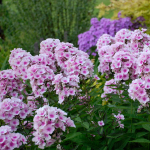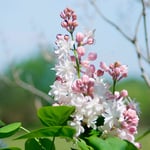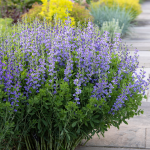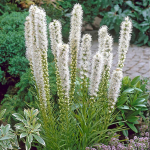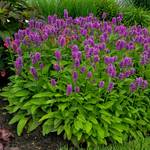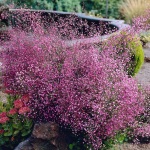Product Details
Producing long, slender stems studded with silvery, rose-colored catkins in early spring, Salix gracilistyla ‘Mt. Asama’ is a favorite shrub for cut branches and a valuable addition to the landscape. One of the Royal Horticultural Society’s Plants for Pollinators, the velvety male flowers of this Rose-gold Pussy Willow are as attractive to pollinating insects as they are beautiful to human eyes. As the catkins fade, blue-tinged foliage emerges and remains for the balance of the season before turning yellow and dropping in fall. This upright, multi-stemmed shrub reaches about 10' in height and width, so it is not one for tight spaces. It is an appropriate selection for wet sites, tolerating some degree of standing water, and is also adaptable to soils with varying textures, pH levels, and even pollutants. Sometimes known in the trade as ‘Mt. Aso.’
Salix is a diverse and cosmopolitan genus of woody trees and shrubs found in a variety of habitats, from riverbanks and meadows to arctic shorelines and rocky scree. In our part of the world, the furry catkins of these plants are as much a sign of spring as the return of red-winged blackbirds.
For more information on growing Salix, click Growing Guide.
Shipping
HOW PLANTS ARE SHIPPED
The size of the plants we ship has been selected to reduce the shock of transplanting. For some, this means a large, bareroot crown. Others cannot travel bareroot or transplant best if grown in containers. We ship these perennials and annuals in 1 pint pots, except as noted. We must point out that many perennials will not bloom the first year after planting, but will the following year, amply rewarding your patience. We ship bulbs as dormant, bare bulbs, sometimes with some wood shavings or moss. Shrubs, Roses, vines, and other woody plants may be shipped bareroot or in pots. The size of the pot is noted in the quick facts for each item.
WHEN WE SHIP
We ship our bulbs and plants at the right time for planting in your area, except as noted, with orders dispatched on a first-come, first-served basis by climate zone. We also ship a wide range of containers and planters, tools, supplies, fertilizers, garden wear, garden decor items, as well as indoor decorations like wreaths and dried bouquets when available. Estimated dates for shipping are indicated in the green Shipping Details box for each item. Please supply a street address for delivery. Kindly contact us with two weeks notice, if you'll be away at the expected time of delivery.
OUR GUARANTEE
We guarantee to ship plants that are in prime condition for growing. If your order is damaged or fails to meet your expectations, we will cheerfully replace or refund it. Please contact our Customer Service Department at 1-800-503-9624 or email us at [email protected]. Please include your order number or customer number when contacting us.
Reviews
There are no reviews yet. Be first to Write a Review.
Growing guide
Latin Name Pronunciation: say'-licks
Salix is a diverse genus of woody trees and shrubs found in a variety of habitats, from riverbanks and meadows to arctic shorelines and rocky slopes. They thrive in full sun or partial shade in average to moist, well-drained soil.
GROWING TREE FORMS
Planting: When you're ready to plant your bareroot tree, fill a 5-gallon bucket, or equivalent container, with water to soak the roots of your plants for an hour or so before they go in the ground or into a container. Unwrap your plant, remove the packing material, and place its roots in the water.
If planting in the ground, dig a hole wide and deep enough to accommodate the roots. Remove your tree from the water and plant the crown at the depth indicated on the plant label, arranging the roots evenly inside the hole. Holding the crown of the plant, push the soil into the hole, working soil around the roots. Firm the soil around the crown, pressing down with both hands. Water thoroughly to settle the soil.
If planting in a container, choose one that is 14–16″ in diameter and use good-quality potting soil. Place the container outdoors for the growing season. Plants in containers dry out more quickly than plants in the ground, so it’s important to water your plants regularly.
To keep your tree standing, put it out of reach of strong winds and support it with a stake that has a diameter at least as large as the stem’s diameter and long enough that when pushed into the soil it reaches inside the head of the tree. Fasten the standard to the stake at several points with garden twine or green plastic tie tape looped in a figure eight around the stem and stake. Check the ties periodically during the growing season. Loosen them if they constrict the outward growth of the stem.
Pruning, Fertilizing, and Repotting: Maintain the shape of the head with selective pinching of the new shoots (too much pinching will prevent the formation of flower buds). Pinch each shoot between thumb and forefinger or cut with pruning shears. Do not shear the plant as though it were a hedge. Fertilize tree forms grown in pots as you would other pot-grown plants by using a balanced, time-release fertilizer.
If you find that your tree in a container starts to dry out quickly after watering, the plant probably needs a larger pot. Lift it from its current pot, make four deep vertical cuts in the root ball, and place it in a new pot that is 2″ wider and taller than the old one, filling in around the root ball with fresh potting mix. Water thoroughly after repotting.
Wintering Over in Containers: In colder climates (Zones 5 and 6) you can overwinter plants in their containers by storing them in a sheltered, unheated area, such as a garage or shed, where temperatures range between 25 and 40°F. Check the potting mix occasionally for moisture, and water as needed. In warmer climates where freeze-thaw cycles occur, store plants on a protected porch. Where freezing is not a concern, plants can remain outdoors in containers and enjoyed year-round.

